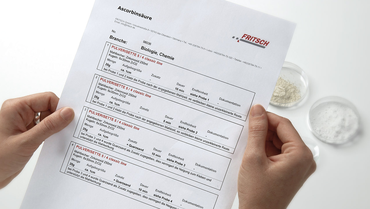Назад к обзору
Vanadium – a metal with unlimited fields of application
Managing the energy transition with new Vanadium rechargeable batteries
The energy controversy moves society. Due to a lack of development, alternative energies can not be made available to the broad masses. A small step in this direction is the development of new rechargeable batteries made of vanadium, which allow unlimited recharging cycles without wear. But as a prerequisite, the suitable processing of this special metal is required. Here, the FRITSCH Cutting Mills and FRITSCH Planetary Ball Mills play a central part in research and development. These make a complex comminution of tough-metallic materials like for example vanadium possible.
A very little past, but a whole lot of future!
The just in the 18th century discovered metal which is considered due to its electronic configuration a transition metal, was processed for the first time 100 years later. With technological progress it was possible to process vanadium so all the characteristics of this element became fully emphasized. With the addition of comminuted vanadium, new metallic characteristics and surfaces could be created. Among others, fine vanadium - beside chrome, nickel, cobalt, tungsten and other metals - is used in a balanced mixture for alloying. Biochemical processes for example of animal cells use vanadium for their metabolism cycle however plant cells need it for photosynthesis for the generation of energy. [1].
A rechargeable battery the size of a railway coach
Ordinary rechargeable batteries are stressed with each charging and discharging cycle and the capacity therefore decreases continuously with these cycles. Newer vanadium-redox flow batteries [2] have 2 electrolyte tanks and can compensate any interactions of procedures. Due to the order of the vanadium ions the space requirement is much higher though, as with common rechargeable batteries of the same capacity. With the commiuntion of Cutting Mills and the ensuing fine comminution for example with the Planetary Micro Mill PULVERISETTE 7 premium line by FRITSCH the specific surface area will become larger with increasing fineness. This directly affects an improved reactivation. The Planetary Mills premium line enable the comminution down to the nano range and are therefore essential in this new battery technology.
Remarkable Transition Metal
Vanadium possesses due to its position in the periodic table of elements particular characteristics [3]:
- non-magnetic
- electrically conductive - superconductor
- tough and forgeable
- easily flammable as a powder
- reacts with non-metals
Complex problems, which are none?
Fine enough sheeted material or also cuts from other stages of production can be comminuted with cutting mills to coarse grained material or even to a powder.
The shown foils were thin enough to be cut directly with the Universal Cutting Mill PULVERISETTE 19. Cutting tools made of hardmetal tungsten carbide and a sieve with a 2 mm trapezoidal perforation were utilized. Due to the high rotational speed of the Cutting Mill PULVERISETTE 19 a high fine fraction is of course obtained.
For the comminution of non-metals, very good results are obtained with the Universal Cutting Mill PULVERISETTE 19l/ 50-700 rpm variable speed: For the pre-comminution if the base material is above 2 mm strong, as well as for the coarse comminution, when a narrow particle size distribution larger than 2 mm sieve throughput or a final fineness between 2 mm – 10 mm shall be achieved.
Ensuing is an additional fine comminution to a finer powder possible without any problems with the Universal Cutting Mill PULVERISETTE 19. Excellent results are available for example also for the fine comminution of aluminium-alloys from the manufacturing of car engines. However, care then has to taken, because fine metal powders are prone to self-ignition. In the present case with the chosen fineness, for additional applications a suitable powder is prepared.
Braced for the future
In order to speed up and advance the reversal of the energy trend consistent and sustainable research is needed. The same principle applies for material research, biochemistry or other areas where vanadium is utilized. Due to FRITSCH Laboratory Mills, which are based upon the most diverse comminution technologies every kind of sample preparation on a laboratory scale is possible without any difficulties and are therefore used for the development of future-oriented technologies.
-
Download the FRITSCH-report as PDF file
-
Detailed grinding reports
-
Sources and continuative literature
[1] Werkstoffkunde 17. Aufl., W. Weißbach, Vieweg Verlag
[2] upload.wikimedia.org/wikipedia/commons/a/ae/Vanadium_battery.svg
[3] Chemie 10. Aufl., C. Mortimer und U Müller, Thieme Verlag
Назад к обзору










